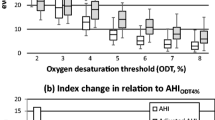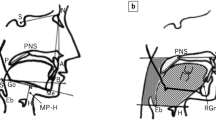Abstract
Objective
A new index, approximate entropy (ApEn) of oxygen saturation, was used to assess the severity of hypoxemia in patients with obstructive sleep apnea-hypopnea syndrome (OSAHS), determine the correlation with other parameters, and explore its clinical value.
Methods
A retrospective analysis was performed on 1200 patients with OSAHS and snorers (normal control). All subjects underwent sleep apnea monitoring for 6 h. Subjects were divided into four subgroups by apnea-hypopnea index (AHI): normal control (AHI < 5), mild OSAHS (5 ≤ AHI < 15), moderate OSAHS (15 ≤ AHI < 30), and severe OSAHS 104 (AHI ≥ 30). ApEn was initially compared among the subgroups. Then a correlation analysis of AHI with ApEn and a correlation analysis of ApEn with oxygen desaturation index (ODI), lowest oxygen saturation (LO2), and T < 90% were performed. (2) The AHI was used as the gold standard, and an attempt was performed to determine the value of ApEn to assess the severity of hypoxemia in OSAHS.
Results
Among the 1200 subjects, 822 subjects were men (72%) and mean age was 53.2 ± 15.2 years (range 24–95 years). The ApEn in each group was significantly different (P <0.001), and the ApEn synchronously increased with AHI. Furthermore, a significant difference in ApEn was found among the groups (P <0.001). In addition, ApEn had a good correlation with ODI, LO2, and T <90%. According to the ROC analysis results, the boundary value of ApEn to judge OSAHS patients with mild, moderate, and severe hypoxia was 16.72, 17.84, and 20.06, respectively.
Conclusion
ApEn synchronously increased with the AHI and had a good correlation with AHI, ODI, LO2, and T <90%. These findings suggest that ApEn may have clinical value for assessing hypoxia severity in OSAHS patients.

Similar content being viewed by others
References
Pincus S (1995) Approximate entropy (Apen) as a complexity measure. Chaos. 5:110–117
Pincus S, Huang W (1992) Approximate entropy-statistical properties and applications. Commun Stat Theory Methods 21:3061–3077
Stergiou N, Harbourne R, Cavanaugh J (2006) Optimal movement variability: a new theoretical perspective for neurologic physical therapy. J Neurol Phys Ther 30:120–129
Faure P, Korn H (2011) Is there chaos in the brain? I. Concepts of nonlinear dynamics and methods of investigation. C.R. Acad. Sci. III. 324:773–793
Wolf A, Swift JB, Swinney HL, Vastano JA (1985) Determining Lyapunov exponents from a time-series. Physica D 16:285–317
Chesson AL Jr, Willam M (1993) Assessment of hypoxemia in patients with sleep disorders using saturation impairment time. Am Rev Respir Dis 148:1592–1598
Kirby SC, Anderson WM, Chesson AL, George RB (1992) Computer quantitation of saturation impairment time as an index of oxygenation during sleep. Comput Methods Prog Biomed 38:107–115
Mutlu LC, Tülübaş F, Alp R, Kaplan G, Yildiz ZD, Gürel A (2017) Serum YKL-40 level is correlated with apnea hypopnea index in patients with obstructive sleep apnea syndrome. Eur Rev Med Pharmacol Sci 21:4161–4166
Sozer V, Kutnu M, Atahan E, Calıskaner Ozturk B, Hysi E, Cabuk C, Musellim B, Simsek G, Uzun H (2018) Changes in inflammatory mediators as a result of intermittent hypoxia in obstructive sleep apnea syndrome. Clin Respir J 12:1615–1622
Rusu A, Bala CG, Craciun AE, Roman G (2017) HbA1c levels are associated with severity of hypoxemia and not with apnea hypopnea index in patients with type 2 diabetes: results from a cross-sectional study. J Diabetes 9:555–561
Song YJ, Kwon JH, Kim JY, Kim BY, Cho KI (2016) The platelet-to-lymphocyte ratio reflects the severity of obstructive sleep apnea syndrome and concurrent hypertension. Clin Hypertens 22:1
Oyama J, Nagatomo D, Yoshioka G, Yamasaki A, Kodama K, Sato M, Komoda H, Nishikido T, Shiraki A, Node K (2016) The relationship between neutrophil to lymphocyte ratio, endothelial function, and severity in patients with obstructive sleep apnea. J Cardiol 67:295–302
Ozanturk E, Ucar ZZ, Varol Y, Koca H, Demir AU, Kalenci D, Halilcolar H, Ozacar R (2006) Urinary uric acid excretion as an indicator of severe hypoxia and mortality in patients with obstructive sleep apnea and chronic obstructive pulmonary disease. Rev Port Pneumol 22:18–26
Pincus SM, Keefe DL (1992) Quantification of hormone pulsatility via an approximate entropy algorithm. Am J Physiol Endocrinol Metab 262:741–754
Pincus SM (2001) Assessing serial irregularity and its implications for health. Ann N Y Acad Sci 954:245–267
Pincus SM (1991) Approximate entropy as a measure of system complexity. Proc Natl Acad Sci U S A 88:2297–2301
Guo XY, Li FJ (2017) Chaotic features on excess/deficiency syndrome of chronic stable angina pectoris based on analyzing approximate entropy of heart rate variability. Zhongguo Zhong Xi Yi Jie He Za Zhi 37:297–301
Byun S, Kim AY, Jang EH, Kim S, Choi KW, Yu HY, Jeon HJ (2017) Entropy analysis of heart rate variability and its application to recognize major depressive disorder: a pilot study. Comput Biol Med. 80:137–147
Skoric T, Mohamoud O, Milovanovic B, Japundzic-Zigon N, Bajic D (2017) Binarized cross-approximate entropy in crowdsensing environment. Comput Biol Med 80:137–147
Tsuji Y, Suzuki N, Hitomi Y, Yoshida T, Mizuno-Matsumoto Y (2017) Quantification of autonomic nervous activity by heart rate variability and approximate entropy in high ultrafiltration rate during hemodialysis. Clin Exp Nephrol 21:524–530
Singh V, Gupta A, Sohal JS, Singh A (2019) A unified non-linear approach based on recurrence quantification analysis and approximate entropy: application to the classification of heart rate variability of age-stratified subjects. Med Biol Eng Comput 57:741–755
Caldirola D, Bellodi L, Caumo A, Migliarese G, Perna G (2004) Approximate entropy of respiratory patterns in panic disorder. Am J Psychiatry 161:79–87
Bastos de Figueiredo JC, Diambra L, Glass L, Malta CP (2002) Chaos in two-loop negative feedback systems. Phys Rev E Stat Nonlin Soft Matter Phys 65:051905
Sharmila A, Aman Raj S, Shashank P, Mahalakshmi P (2018) Epileptic seizure detection using DWT-based approximate entropy, Shannon entropy and support vector machine: a case study. J Med Eng Technol 42:1–8
Burioka N, Cornélissen G, Halberg F, Kaplan DT, Suyama H, Sako T, Shimizu E (2003) Approximate entropy of human respiratory movement during eye-closed waking and different sleep stages. Chest 123:80–86
Caldirola D, Bellodi L, Caumo A, Migliarese G, Perna G (2004) Approximate entropy of respiratory patterns in panic disorder. Am J Psychiatry 161:79–87
Levy P, Pépin JL, Deschaux-Blanc C, Paramelle B, Brambillaet C (1996) Accuracy of oximetry for detection of respiratory disturbances in sleep apnea syndrome. Chest 109:395–399
Author information
Authors and Affiliations
Corresponding author
Ethics declarations
Conflict of interest
The authors declare that they have no conflict of interest.
Research involving human participants and/or animals
All procedures performed in studies involving human participants were in accordance with the ethical standards of the Peking Union Medical College Hospital committee and with the 1964 Helsinki Declaration and its later amendments or comparable ethical standards.
Informed consent
Informed consent was obtained from all individual participants included in the study.
Additional information
Publisher’s note
Springer Nature remains neutral with regard to jurisdictional claims in published maps and institutional affiliations.
Rights and permissions
About this article
Cite this article
Liu, J., Huang, R., Xiao, Y. et al. ApEn for assessing hypoxemia severity in obstructive sleep apnea hypopnea syndrome patients. Sleep Breath 24, 1481–1486 (2020). https://doi.org/10.1007/s11325-019-02004-0
Received:
Revised:
Accepted:
Published:
Issue Date:
DOI: https://doi.org/10.1007/s11325-019-02004-0




